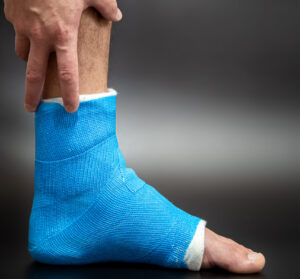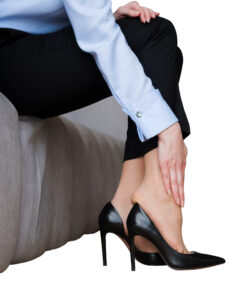JUMP TO THE TOPIC
ToggleINTRODUCTION

Did you ever feel discomfort in your ankle while squatting? Well this may be because of poor ankle mobility. You need not worry about it anymore, we got you covered in this article we’re going to learn how to improve ankle mobility for squats. Without further delay let’s get stratight to the point.
Ankle mobility is crucial for lower body movements like squats where your ligaments are challenged at the depth of your movement. Now if you are someone that’s struggled with poor ankle mobility for some time, you might have experienced some range of acute back pain. As to compensate for the lack of mobility of one muscle group, tendon or ligament, your body tend to involve other muscle groups, tendons or ligaments more than they are required which may affect your overall posture and balance, all the more reason for you to understand how to improve ankle mobility for squats.
Ankle mobility for squats is essential for achieving proper squat form. Without sufficient range of motion in your ankles, you may struggle to reach full depth, maintain balance, and avoid injury. In this article, we’ll discuss why ankle mobility for squats and other lower body movements matter, common issues that can limit your mobility, and provide practical exercises to help you improve your range of motion and squat performance and thus improving flexibility and ankle mobility for squats.
Understanding Ankle Mobility.
what is Ankle mobility?Ankle mobility refers to the range of motion available at the ankle joint, allowing for movements like dorsiflexion (bringing the foot closer to the shin) and plantarflexion (pointing the foot away from the shin). Proper ankle mobility is essential for various physical activities, including walking, running, jumping, and particularly squatting, as it allows for optimal movement patterns and reduces the risk of injury.
Key Components of Ankle Mobility
1.Dorsiflexion:
• The movement where you bring the toes closer to the shin.
•Crucial for movements that require a deep bend in the ankle, such as squatting and lunging. Limited dorsiflexion can result in compensatory movements in other joints, leading to improper form and potential injuries.
2.Plantarflexion:
• The movement where you point your toes away from the shin.
•Essential for actions like pushing off during running or jumping. Good plantarflexion contributes to the overall flexibility and functionality of the ankle.
3.Inversion:
•The movement where you turn the sole of your foot inward.
•Helps in maintaining balance and stability during various activities. It’s particularly important for lateral movements and activities that require quick changes in direction.
4.Eversion:
•The movement where you turn the sole of your foot outward.
•Works alongside inversion to maintain balance and stability. Eversion is also important for preventing ankle sprains and injuries during activities that involve side-to-side motion.
During a squat, your ankles need to flex to allow your knees to move forward, helping you maintain balance and proper posture. Limited ankle mobility can lead to compensatory movements, increasing the risk of knee and lower back injuries.
Common causes that lead to poor ankle mobility.
Sedentary Lifestyle
Lack of movement can lead to stiffness of your muscles including the ones present around your ankles. Spending long hours sitting can cause the muscles around the ankle to become tight and restricted and needs to be stretched in order to loosen and improve ankle mobility.
Injury History

Any past episode of injuries may also lead to poor ankle mobility like sprains can lead to scar tissue, micro tears and reduced flexibility limiting your range of motion. It is important to include mobility exercises in your schedule as a part of injury rehab thus making it better than before and improving ankle mobility.
Footwear
People often ignore the need of a well fitted footwear when it comes to ankle mobility you should prefer shoes that have enough room around your ankle without reducing the support and not to mention room around your toes shouldn’t be ignored for other complexities that may arise. Wearing shoes with elevated heels or poor support can also alter your natural gait and restrict ankle mobility.
Start by throwing away if you a footwear like any of the above characteristics as the first step to improve ankle mobility. Kudos to you if you already have right sized footwear, which means this was not your cause for poor ankle mobility, so keep reading to find out what is stopping you from hitting those ‘Ass to grass’ squats and also to find out the answers in your quest to improve ankle mobility.
Anatomical Differences

Some people naturally have more restricted ankle joints due to their bone structure, which can impact their mobility. However there’s nothing that we don’t have the solution for 😉
Assessing your Ankle Mobility
Here are a few tests you can do at home to check the condition of how mobile your ankles are and then work upon them to improve ankle mobility for squats.
1. Wall Test:
This test helps you determine the flexibility of your ankle and its ability to dorsiflex, or bring your toes closer to your shin.
How to do?
1. Find a Wall: Stand facing a wall with your toes about 4 inches (10 cm) away from it.
2. Position Your Foot: Place one foot flat on the ground, keeping your heel down and your toes pointing straight ahead.
3. Move Your Knee: Slowly bend your knee and try to touch it to the wall without lifting your heel.
4. Assess: If your knee can touch the wall without your heel lifting, your ankle mobility is good. If you can’t, you might need to work on improving your ankle flexibility.
Perform this test on both ankles, as one may be more flexible than the other.
2. Knee-to-Wall Test:
This test is specifically designed to measure the range of motion in your ankle, particularly dorsiflexion.
How to do?
1. Start Position: Stand facing a wall with one foot about 4 inches (10 cm) away from it. Your other foot can be positioned slightly behind you for balance.
2. Foot Placement: Place your toes against the wall.
3. Knee Movement: Bend your knee and try to touch it to the wall while keeping your heel flat on the ground.
4. Measure Distance: If you can touch the wall, move your foot back slightly and repeat until you find the maximum distance at which you can still touch the wall with your knee without lifting your heel. Measure this distance from your big toe to the wall.
Perform the test on both sides to compare ankle flexibility. A difference in range of motion between the ankles can indicate an imbalance that may need addressing.
3. Ankle Lunge Test:
This test helps assess the overall mobility of your ankle by observing how far your knee can travel over your toes without your heel lifting off the ground.
How to do?
1. Starting Position: Stand with one foot in front of the other in a lunge position.
2. Foot Placement: Ensure your front foot is flat on the ground and your back foot is comfortably positioned for balance.
3. Lunge Movement: Bend your front knee and try to move it as far forward over your toes as possible without letting your heel lift off the ground.
4. Observe: Notice how far your knee can move forward and whether your heel stays grounded.
Perform this test on both legs to check for any differences in mobility.
By using these simple tests, you can get a good idea of your current ankle mobility and identify areas that may need improvement. Regularly practicing these tests can also help track your progress over time as you work on enhancing your ankle mobility.
Exercises that’d help to improve Ankle Mobility for squats
1.Dynamic Warm-Ups:
•Ankle Circles:
Start by placing a foam roller or rolled mat under your ankle and the whole body laid flat on the floor with torso upright.
Rotate your ankle in circles, first clockwise and then counterclockwise, to loosen up the joint.
•Heel Raises:
Stand with your feet hip-width apart and slowly rise onto your toes, then bend from lower back to touch your palms to your toes in order to stretch and strengthen your calves.
2.Static Stretches:
•Calf Stretch:
Stand facing a wall, place your hands on it for support, step one foot back, and press the heel into the ground to stretch the calf muscle. Hold for 30 seconds and repeat with the other foot.
3.Mobility Drills:
•Ankle Dorsiflexion with a Resistance Band:
Secure a resistance band around a sturdy object, loop it around your ankle, and move your foot forward to increase the stretch on the ankle joint.
4.Strengthening Exercises:
•Tibialis Anterior Strengthening:
Sit with your legs extended, place a resistance band around your foot, and pull your toes towards you against the band’s resistance.”
Some tips that you should keep in mind to improve ankle mobility for squats.
Here are a few basic but necessary tips you must follow if you want to improve ankle mobility for squats
1. Consistency:
For everything to turn out good, just having the knowledge about it won’t make it work you have to be consistent in it and I quote “Practice makes a man(human) perfect”
Incorporate ankle mobility exercises into your daily routine to see continuous improvement.
2.Progress:
Keep doing the tests we mentioned above to measure your progress.
Keep a log of your ankle mobility exercises and test results to monitor your progress and stay motivated.
3.Combining with Other Movements:
Try to integrate Ankle mobility exercises in your pre-workout warmup to make those muscles alert.
Add ankle mobility drills to your pre-squat warm-up to ensure your joints are ready for action. Then hit the depth in those squats and don’t forget to include these exercises in your after workout routine to improve ankle mobility.
4. Nutrition:
We say it always and we’ll say it again, focus on your nutrition to get the best results from your workout.
Keep a check of your macronutrients and micronutrients to improve ankle mobility inside out. If you are worried what to have in your post workout meal you can read here to know more.
Some common mistakes to avoid
1. Overstretching:
• Over doing of anything brings more bad than good.
• Having said that avoid pushing your stretches too far too quickly, as this can lead to injury rather than improvement.
2. Neglecting Strength:
• Later in your life your body would thank you for combining flexibility with strength. You could have the best of both worlds.
• While stretching is crucial, don’t forget to strengthen the muscles around your ankle to support improved mobility.
3. Ignoring Pain:
• While there’s a slight difference in discomfort and pain, understanding the cause of both of them is important.
• If you experience sharp pain during mobility exercises, stop immediately and consult a professional, as this could indicate an underlying issue.
Conclusion
Poor ankle mobility may be inhibiting you from reaching your full potential on squats. But by doing regular stretching and mobility exercises will allow you to improve your performance on squats, with injury free movement. Understanding what is the cause of poor ankle mobility and it’s importance sets the foundation for effective movement and stability in various physical activities.
By identifying common causes of limited ankle mobility, such as a sedentary lifestyle, past injuries, inappropriate footwear, and anatomical differences, you can take targeted steps to address these issues. Assessing your ankle mobility with simple tests like the Wall Test, Knee-to-Wall Test, and Ankle Lunge Test provides insight into your current range of motion and highlight areas that need improvement.
Incorporating a combination of dynamic warm-ups, static stretches, mobility drills, and strengthening exercises into your routine can significantly enhance your ankle flexibility and strength. Consistency and careful tracking of your progress will help ensure sustained improvements and better overall performance in activities like squatting.
Avoid common mistakes such as overstretching, neglecting muscle strength, and ignoring pain signals for further complications. By taking a balanced and informed approach to improving ankle mobility, you can achieve a greater range of motion, improve your squat depth and form, and reduce the risk of injuries, leading to a more effective and enjoyable fitness journey.
Remember, improving ankle mobility is a gradual process that requires patience and dedication. Stay consistent with your exercises, monitor your progress, and adjust your routine as needed. Your efforts will pay off with enhanced movement, better athletic performance, and a lower risk of injury.
Hope we were able to help you in your worry about how to improve ankle mobility for squats. If yes please share this article with any of your other friends who might be struggling with poor ankle mobility. Also share your progress with us in the comment section down below, we would be happy to know that we were able to help you.
Now go and start working on improving ankle mobility for squats. Cheers to a fit lifestyle!!
References
1. 23-Dec-2020 Improving Ankle mobility through touch and exercise (by Orthopaedic Medical group of Tampa bay)
2. Glossary of foot and ankle terms (American Orthopaedic Foot and AnkleSociety)
